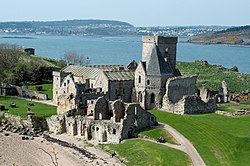This article includes a list of general references, but it lacks sufficient corresponding inline citations .(November 2014) |
 Photograph, 9 April 2011 | |
| Monastery information | |
|---|---|
| Order | Augustinian |
| Established | 1147 x 1169 (priory)/ 1235 (abbey) |
| Disestablished | 1609 |
| Diocese | Diocese of Dunkeld |
| Controlled churches | Aberdour; Auchtertool; Beath; Dalgety; Dollar; Leslie; Rosyth |
| People | |
| Founder(s) | David I of Scotland & Gregoir, Bishop of Dunkeld |
| Important associated figures | Walter Bower |
Inchcolm Abbey is a medieval abbey located on the island of Inchcolm in the Firth of Forth in Scotland. The Abbey, which is located at the centre of the island, was founded in the 12th century during the episcopate of Gregoir, Bishop of Dunkeld. Later tradition placed it even earlier, in the reign of King Alexander I of Scotland (1107–24), who had taken shelter on Incholm when his ship was forced ashore during a storm in 1123. It is said he resided there for three days with the Hermit of Incholm. [1]
Contents
The Abbey was first used as a priory by Augustinian canons regular, becoming a full abbey in 1235. [2] The island was attacked by the English from 1296 onwards, [3] and the Abbey was abandoned as a result of the Scottish Reformation in 1560. [4] It has since been used for defensive purposes, as it is situated in a strategically important position in the middle of the Firth of Forth. A Latin inscription carved above the Abbey's entrance reads:
Stet domus haec donec fluctus formica marinos ebibat, et totum testudo perambulet orbem
Translated, it has been rendered thus: [5]
"Still may these turrets lift their heads on high,
Nor e’er as crumbling ruins strew the ground,
Until an ant shall drink the ocean dry,
And a slow tortoise travel the world round."
Inchcolm Abbey has the most complete surviving remains of any Scottish monastic house. The cloisters, chapter house, warming house, and refectory are all complete, and most of the remaining claustral buildings survive in a largely complete state. The least well-preserved part of the complex is the monastic church. The ruins are cared for by Historic Environment Scotland, which also maintains a visitor centre near the landing pier (entrance charge; ferry from South Queensferry).
In July 1581 stones from the abbey were taken to Edinburgh to repair the Tolbooth. [6]
Among the Abbots of Inchcolm was the 15th-century chronicler Walter Bower.